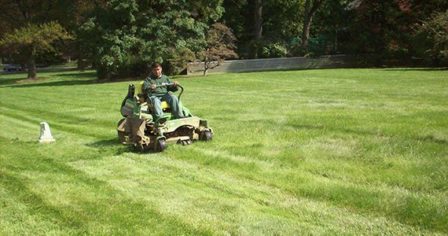Lawn Care is one of those things that often get overlooked in the series of “Dad talks” we get. Between teaching us kindness, responsibility, accountability, right from wrong, and “The Talk” (you know what I mean), lawn care is forgotten. Somehow, it just seems less important than the other things. Weird, right?
However, proper trimming, edging, and mowing practices have a dramatic impact on how the rest of your lawn care program (fertilization, weed control, etc.) work. All the “weed and feed” in the world won’t have any impact if you’re fighting bad cultural practices.
Here are some things the “Dad talks” overlooked.
Edging and Trimming are different tasks
We often hear these terms used interchangeably. That is not the case.
“Trimming” refers to cutting the turf height horizontally, just like your lawn mower does. Trimming is performed in places the mower cannot reach, like at the interior corner of a fence. The mower’s turning radius will not usually allow for mowing all the way to the fence. In that instance, trimming is necessary in that area to cut all the grass. This ensures an even height and look across the whole lawn.
“Edging” refers to a vertical cut to the lawn. Edging is done along the border of bed spaces. It is also usually done along driveways, sidewalk, and patios. Edging puts a fine “edge” in the soil level that defines a space or prevents turf from encroaching on these areas.
The confusion usually comes from the fact that many people use the same equipment to perform both tasks. Even though there are power edging tools specifically for this purpose, homeowners often use a string trimmer for the edging. This involves turning the trimmer upright, so the string is cutting at a 90-degree angle. The equipment used is entirely a matter of preference. However, edging with a string trimmer does require practice to make sure you’re not damaging the turf!
 Improper Mowing, Trimming, and Edging can seriously damage your turf
Improper Mowing, Trimming, and Edging can seriously damage your turf
Doing these basic and seemingly easy tasks improperly can wreak havoc on your lawn.
The real danger here is called “scalping,” and it basically like it sounds – cutting the plant all the way down to the soil level. This happens when you’ve deliberately set the mower height on a setting that is too low. Another cause is when a string trimmer is used to cut the plants too close to the ground. A common place you’d see this is near a fence post or near the curb.
This does some really detrimental things to your turf
First, most of the grass plant’s moisture and nutrients are stored in the leaf tissue. Cutting too much off reduces the ability to withstand heat and drought stress. We have cool-season grasses that don’t like hot, dry weather, so this resilience is important.
Secondly, it allows more sunlight to the soil. According to the Missouri Botanical Gardens, this increase in soil temperature and drying of the soil can “force the grass into dormancy or kill it outright.”
You should always follow the “one-third” rule for mowing or trimming cool-season grasses. Here it is: Don’t take off more than one-third of the grass blade at one time. It’s that simple. Any more than that causes lots of unnecessary stress on the plant.
Improper edging can be problematic, too. You want to keep the turf from spilling onto the sidewalk. You DO NOT want to create a ½-inch-wide groove of exposed soil between the sidewalk or curb and the lawn. All that exposed soil is going to be a headache, as it will allow weeds to grow in the lawn – which leads me to the next point….
Mowing too low causes weed problems
I had a client once that coached soccer. He was nuts about his lawn. He loved the clean, even look of a “pitch.”
The problem was that he didn’t have a soccer pitch. He had a residential lawn in the suburbs. But he tried to mow the lawn like it was an athletic field that has a ball rolling across it constantly. In this case, the two were mutually exclusive.
Your lawn has a pretty neat natural defense mechanism against weeds – staying long. The very best defense against weeds and crabgrass is to have thick, healthy turf. When the grass is longer, airborne weed seeds (dandelion, groundsel, etc.) never make contact with the soil.
No soil contact, no germination
In case you missed this in grade school, a seed has to actually be touching the soil in order to germinate. It is really that basic.
When you mow or trim the lawn so short that the soil is actually exposed (not covered by grass blades), you create the opportunity for weeds to make soil contact. Weeds will germinate just as readily in soil (and some cases better) than grass will. Allowing the turf to stay a bit longer will help with weed control. For our area, aim for a height of about 3” after the lawn has been mowed.
To prevent mowing too low or “scalping,” try to adjust your mower’s setting before you begin. I recommend a nice, flat, level surface (like your garage or carport) to start with. Adjust the mower’s wheels until the bottom of the deck is almost 3” off the ground. This will ensure the blades, which are only slightly higher than the edge of the mower deck, are at the proper height.
If you cannot get your mower to the recommended 3” mark, raise the deck to the highest possible setting. You may also want to consider purchasing a new mower altogether.
Your brand-new lawn mower is not cutting the lawn cleanly
A clean cut of the grass blades is really vital to turf health as well.
When the blades are not cut cleanly, what happens is a “tearing” of the leaf tissue. This leaves behind a stringy, fibrous end to the leaf that turns brown after a day or two. When this coincides with an application by your lawn care provider, it’s easy to assume it was their fault.
I’ve dealt with this more than once. A client says something like “You treated for weeds and now the whole lawn is brown.” What actually happened is they mowed the day after the application, noticed this “tearing” days later, and assumed it was their lawn care company. They made this assumption because they have a “brand-new lawn mower,” so it can’t be that! Can it?
Safety is the name of the game
The reality is: the company that produced your mower has the same concerns anyone in business does – employee safety. Employees at these factories have to physically handle the equipment for quality control and packaging. If you were the business owner, would you want employees handling that equipment with super-sharp blades attached? Of course not!
The problem is that this “tearing” can cause problems with aesthetics. The bigger problem though is that torn blades are more susceptible to diseases. Many types of fungal infections on the turf plants can develop in these tiny tears, where moisture is leaking out of the plant and there’s ample tissue for the fungus to grow. A clean cut takes away the material that would act as a host for the disease. This means your lawn is less likely to develop disease problems.
Make sure you have your mower (even “brand-new”) serviced before cutting. Whether you DIY it or take it to a professional, oil changes, blade sharpening, and sparkplug cleaning should all be done prior to your first mowing. (Obviously, the oil change and spark plug aren’t as critical on a new mower, but you get the idea!)
Cultural practices are a huge part of maintaining the health of your turf. We’d be happy to discuss how your mowing habits are affecting the health of your lawn. Contact Us today to schedule a free lawn care consultation with one of our knowledgeable Account Managers, and get your lawn back on-track this year.
The post What Dad Never Told You About Lawn Care – Mowing, Trimming, and Edging appeared first on Tomlinson Bomberger.
from Tomlinson Bomberger https://ift.tt/2EDG7au

No comments:
Post a Comment